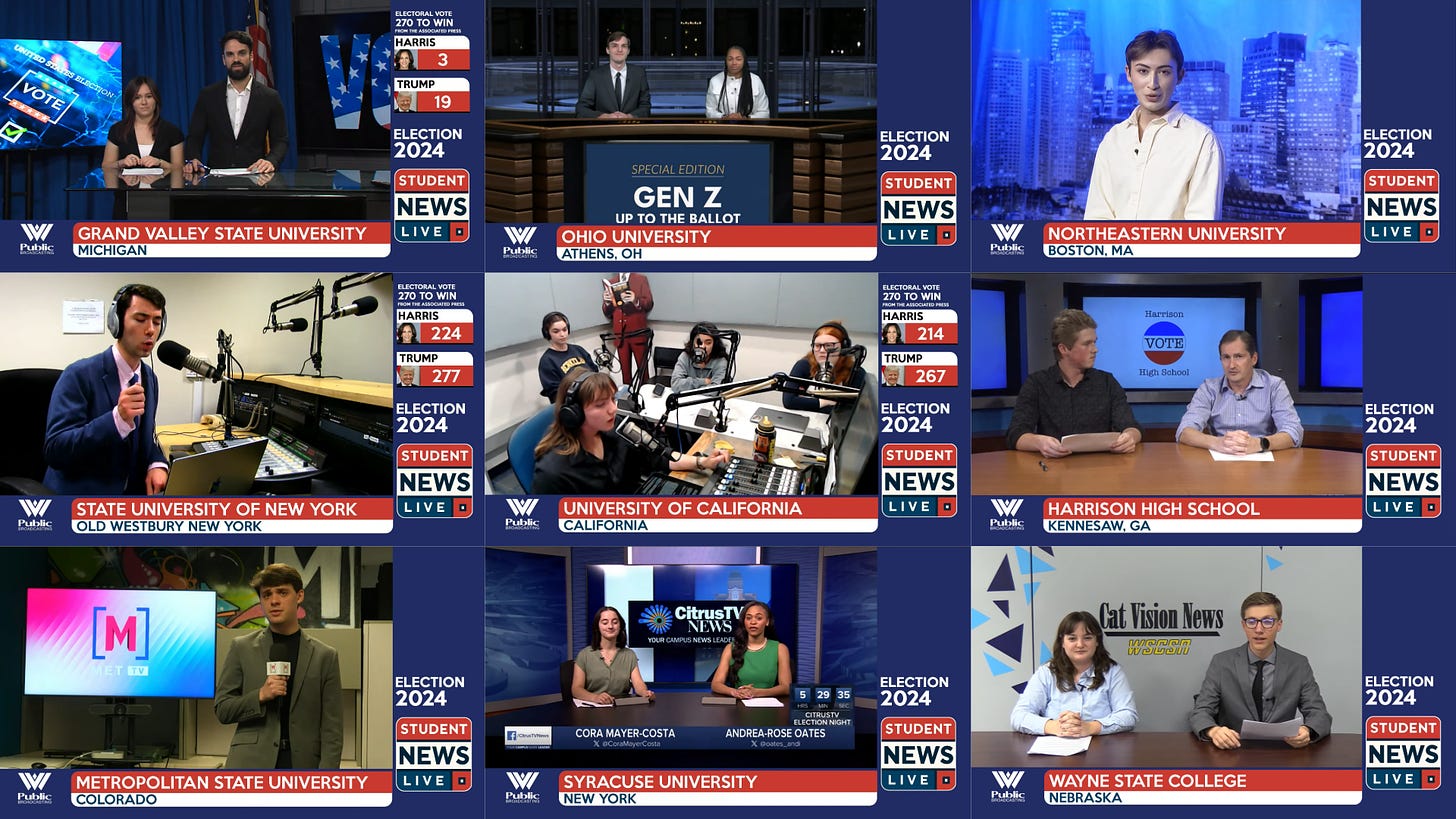How over 120 student newsrooms unite for 24-hour election broadcast
Student News Live brings together student journalists coast to coast for nonstop Election Day coverage
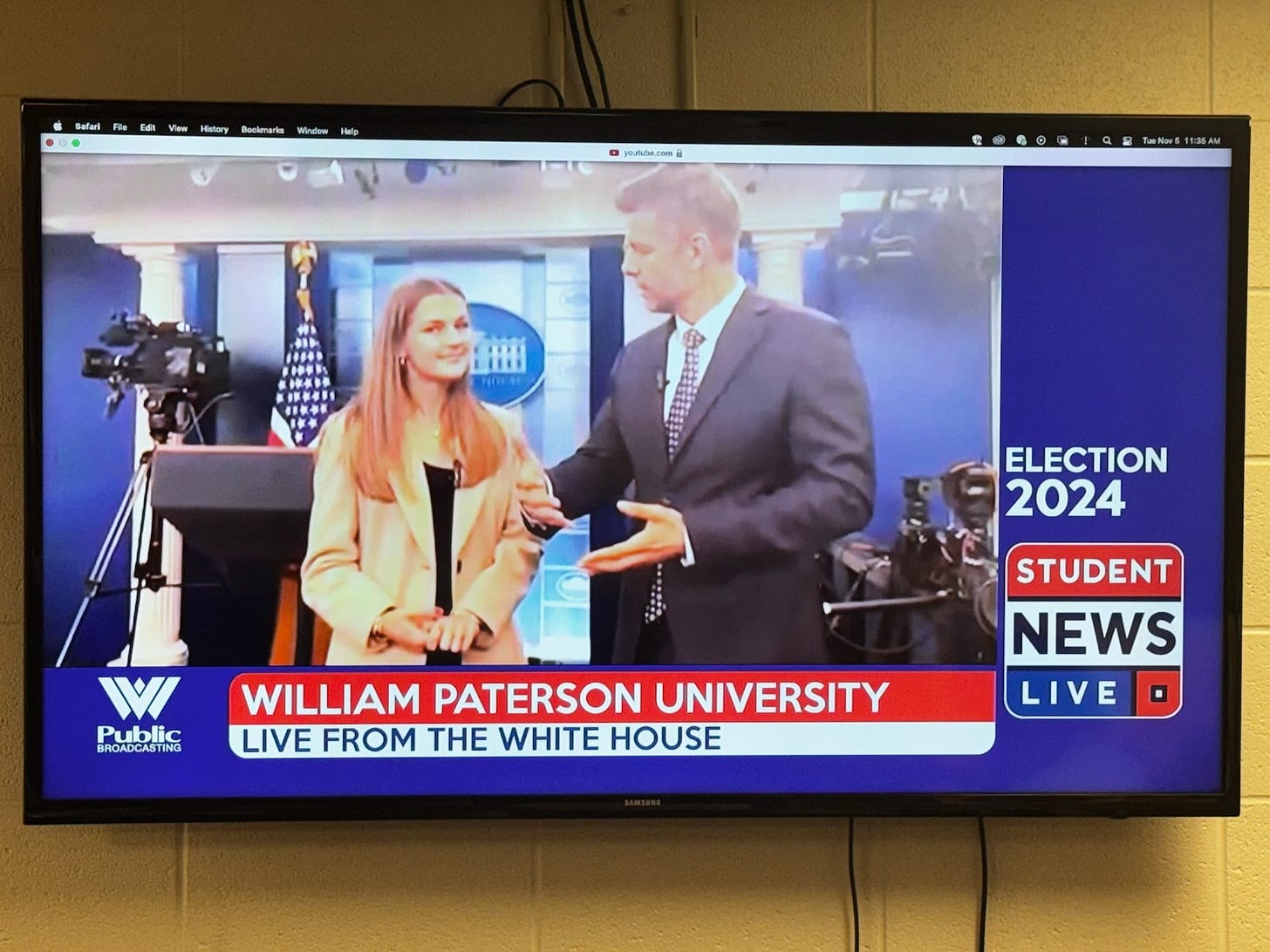
Julia Menn never expected to report live on the presidential election from the White House as a German international student and first-year journalism major.
But last Tuesday, that’s exactly what she did.
“I saw so many people working professionally on this fast-paced day where everything happened really quick and we needed to react to unexpected things,” said Menn, who studies at William Paterson University in New Jersey.
To prepare, Menn researched key election issues, young voter priorities and global perspectives.
“I still can’t really believe this actually happened to me,” she said.
Menn was a correspondent for Student News Live, a coalition of student journalists from more than 120 schools that provided 24-hour live coverage on Election Day, from noon Tuesday to noon Wednesday.
This coverage spanned beyond the White House to include election results, local races and young voters’ reactions, offering a grassroots view from coast to coast.
The center of it all was at Marshall University in West Virginia, where the broadcast headquarters were based. It was here that journalism professor Rob Quicke came up with the idea earlier this year.
How it came to life
Noticing a lack of student engagement in politics, Quicke wondered why young voices weren’t heard more in such a critical election.
“The concept was there that we created an organization that would cover major events not just the election,” he said. “We would do more than this but for an entirely student-produced perspective.”
He reached out to his former colleague at William Paterson, Nick Hirshon, who bought into the idea right away.
“This is a terrific way to introduce students to breaking news of the most momentous moment in history,” Hirshon said. “So I’m on board with any project that will help young journalists learn more.”
Quicke and Hirshon began recruiting students, emphasizing diverse representation from both prominent journalism schools and smaller programs.
With backing from minority journalism associations, they broadened the project’s reach, aiming to make participation as accessible as possible.
Students only needed a phone camera or Zoom to go live for 30-60 minutes.
This way, “working-class students would still have the possibility of being a live correspondent for us,” Hirshon said, noting that those without access to professional equipment could still participate.
Students could also contribute by submitting web stories, live blogs, podcasts, pre-recorded packages or class projects.
“We’re not turning anyone away,” Quicke added.
Schools involved included Syracuse University, Wayne State College, Grand Valley State University, Harrison High School in Georgia, Texas A&M University, and Santa Monica College.
The project was supported by NBCU Academy, PBS News Student Reporting Labs, iHeartRadio, West Virginia Public Broadcasting and the Student Press Law Center.
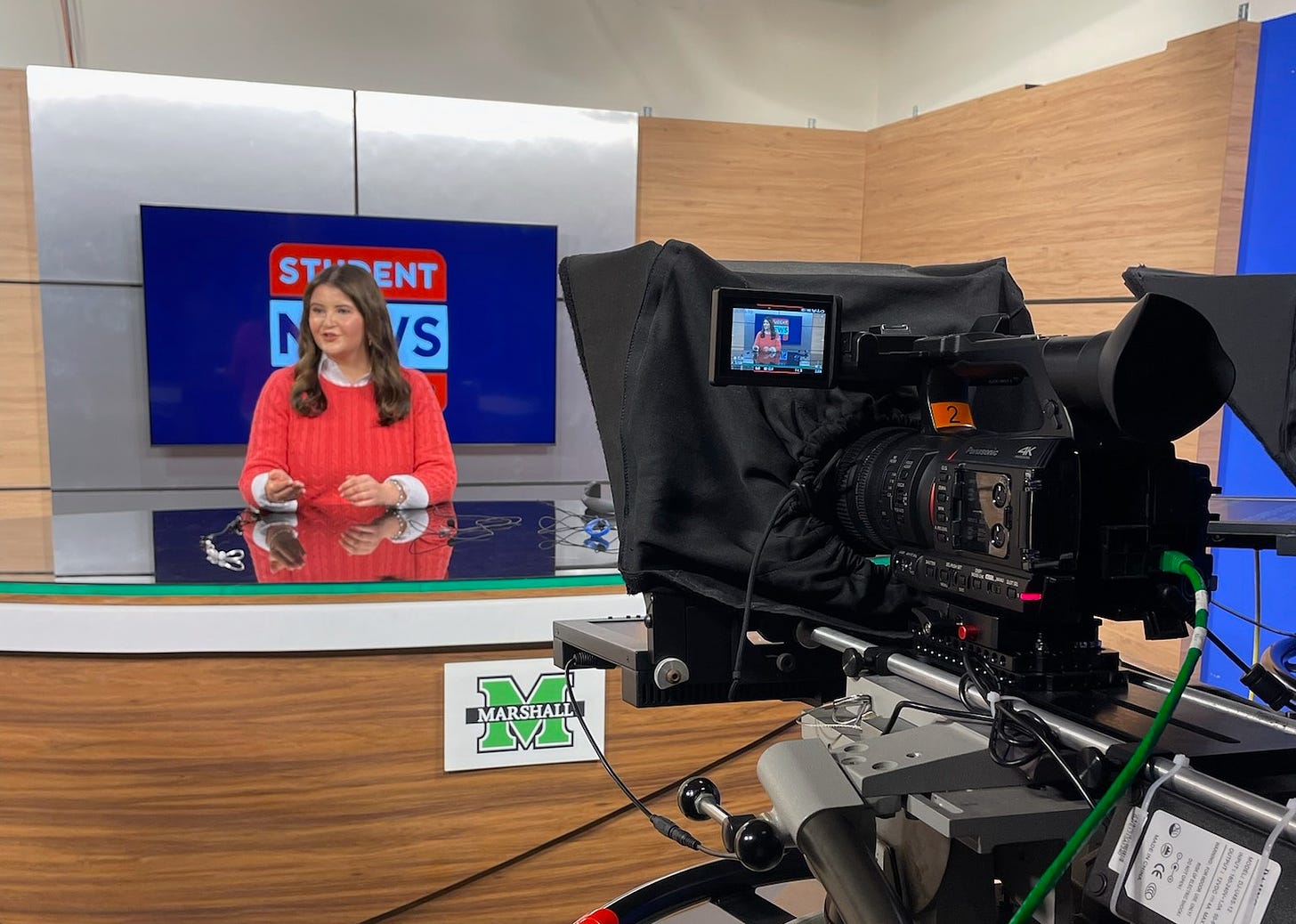
Completely student-led
After the initial groundwork laid by the two professors, Student News Live was completely student-led.
Once a student outlet applied, it wasn’t the professors who responded but rather other students. More than 40 Marshall University students handled everything, from recruitment and digital media production to scheduling — all unpaid.
Among them was Sarah Davis, a junior journalism major and the project’s digital media editor. The scale of the project was daunting to her.
“With any big project, you’re going to have nerves, you’re going to be stressed out about it,” Davis said. “There’s a huge difference between talking about doing it versus actually doing it.”
She coordinated digital news staff from Marshall to cover the whole 24 hours. She admitted persuading students to work late-night shifts was hard.
“I’m actually looking forward to the middle of the night shift,” she said two weeks before Election Day, explaining that the midnight hours would reveal students’ passion for the work.
Each student outlet had the freedom to choose its content within editorial guidelines, which included focusing on second-day stories, maintaining a nonpartisan stance, ensuring FCC compliance, highlighting youth voices and centering local perspectives.
William Paterson political science student Alexander Felix co-hosted a panel on mis/disinformation, inspired by “outlandish things” and “blatant lies” he saw on social media.
He said the topic would help students recognize the importance of being skeptical of what they see online.
“Otherwise, your ideologies and what you believe about a candidate, a person, a party are completely skewed,” he said. “We want people to be kind of investigative, if you will, with consuming media.”
For Quicke, this project was all about empowerment.
“This is an all-hands-on-deck moment in a good way,” he said. “And that's students uniting and coming together to produce something.”
Logistics ‘crazy in the best way’
The “ambitious” program covered Election Day across time zones, with student journalists from various colleges contributing live and pre-recorded content from coast to coast.
At 3:30 p.m., viewers saw Citrus TV’s Alex Burnstein and Peter Barry from Syracuse University analyzing a key race in upstate New York.
By 5 p.m., Emily Dempsey of Suffolk University in Boston was on air, announcing, “Today is Election Day, and we have a great show for you tonight.”
As midnight neared on the East Coast, reporters from Santa Monica College covered a watch party, then passed the broadcast to WKNC at North Carolina State University.
Quicke said they gathered 200-300 pieces of content from hundreds of student journalists, and the challenge was to create a continuous, collaborative schedule that accommodated different conditions.
“We wanted to get high schools involved,” Quicke said, “but one school, they said, ‘We can’t stay past 5 p.m. because the janitor comes and locks the room.’”
Hirshon said many teachers asked logistical questions like “How do we get our content from California to Marshall in West Virginia?”
“All of those are things that we’re figuring out for the first time, on the fly — just like a lot of what we do in higher education,” he said.
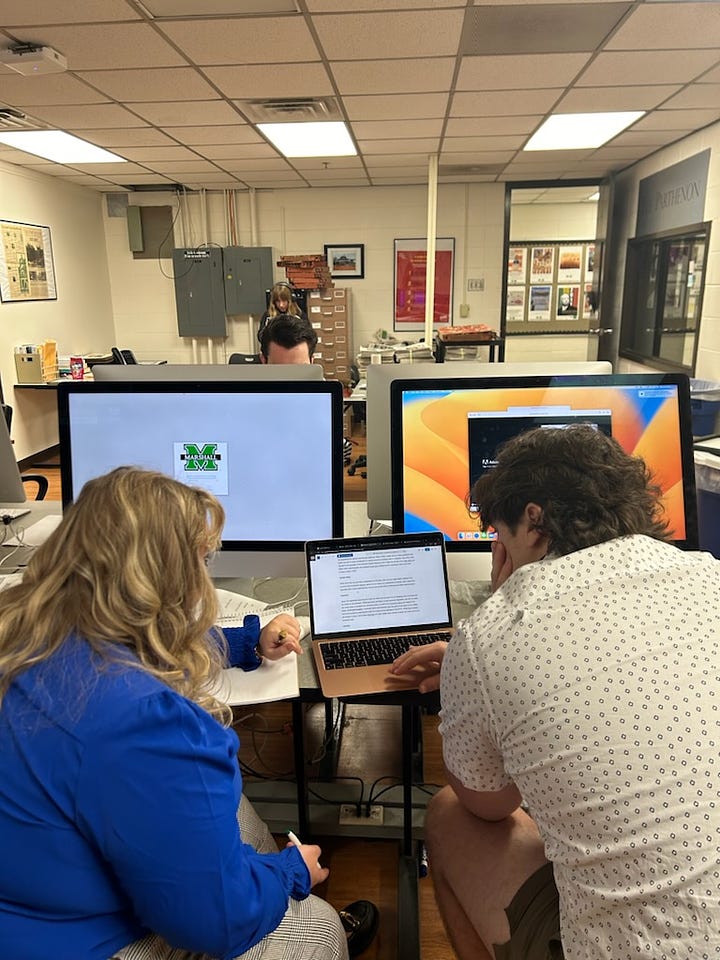
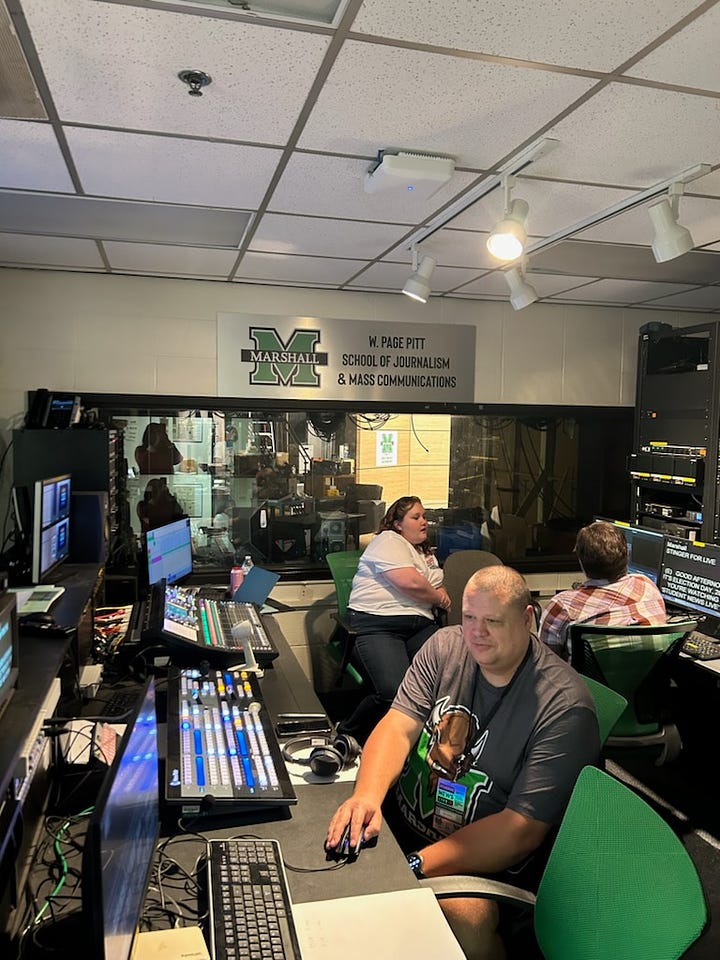
The project’s coordination ran through Discord, with dedicated channels for podcasting, TV, video, social media and digital media.
Students joined test runs and two all-team meetings before the event. Live broadcasts connected through VDO.ninja, while pre-recorded videos were uploaded to a shared Dropbox.
Marshall served as the master control hub, with each school joining a Discord call just before going live.
The setup involved multiple moving parts, with control operators, producers and directors from each school to link up seamlessly.
“I mean, this is crazy in the best way that we’re putting together teams of correspondents from coast to coast,” Quicke said. “These people have never met each other before.”
For future events, Quicke envisioned other schools taking a turn as the central headquarters, believing that this student-driven newsroom could keep growing.
‘Transformational’ for student journalists and audience
Student journalists often feel their work is overlooked, but this project aims to change that.
For Davis, the goal was to show that student journalists offer valuable perspectives — not only within journalism but also for society as a whole.
Hirshon highlighted the benefits for the audience, noting that public mistrust of mainstream journalism is high, with many believing journalists have an agenda — a stark difference from the trust he recalled growing up in the '90s and early 2000s.
“We can show the public, hopefully through this programming, there’s a lot to be excited about in journalism on the horizon,” he said.
The experience is transformative for students, too.
Both Hirshon and Quicke saw this as a launchpad into media careers, offering skills learned directly from professionals. Hirshon called this “the greatest return on investment.”
But ultimately, Quicke said, “It’s an important initiative for students to have a place at the table when it comes to discussing the important events of the day that will affect them and of course, everyone else in the country.”
What student journalists in 50 states tell us about 2024 elections
If you’ve been following election updates, you know the big headlines — but student journalists across the country have been capturing the local pulse with stories that d…
💬 I want to hear from you: What topics do you want covered in the newsletter? Who do you want to hear from? Reach me at nutgrafnews@gmail.com.
Story Spotlight:
🗳️ Student editors across the country reacted to Trump’s victory in their editorials:
The Beacon: “Another Trump presidency is here, but resilience lies within our students.”
Technician: “We fully expect this attack on the press, and thus an attack on democracy, to continue in Trump’s next term.”
The Daily Pennsylvanian: “Trump does not represent Penn.”
The Student Life: “The next four years are not prewritten.”
The Daily Eastern News: “Political divide is only going to worsen, turning into an even more gruesome sight between Americans.”
The Columbia Chronicle: “Trump’s win is setback for change, but we can’t give up.”
✉️ In a letter to young journalists, Columbia professor Samuel Freedman wrote the decline of democracy and the rise of authoritarianism demand a radical shift in journalism, urging the next generation to embrace advocacy, challenge power and rebuild local journalism.
📝 California Polytechnic State University settled a public record lawsuit with a Mustang News reporter. The case involved records related to campus sexual assault and harassment complaints.
🧑🏫 At Manhattan College, a senior administrator talked about how The Quadrangle’s presence on campus has significantly impacted his decision-making process as the executive vice president.
✍️ Student journalists want to cover politics. But not everyone agrees they should, Education Week reported.
Featured Opportunities:
Join Canva for a panel on “Canva 101 for journalists – A beginner's guide” Nov. 19.
McClatchy is hosting its last news internship information session Nov. 19.
The Hill has internships for its editorial and creative departments. Apply before Nov. 15 for spring.
Apply to the Financial Times summer internships before Nov. 16. Openings include newsroom, audience engagement, data and audio roles.
The Nation is seeking applications from graduating students for its full-time internship program until Nov. 24.
Politico has internship openings in Trenton, Albany and Tallahassee. Apply before Nov. 30.
The Wisconsin Jewish Chronicle is offering a half-time remote journalism internship with 1-2 openings for summer 2025.





